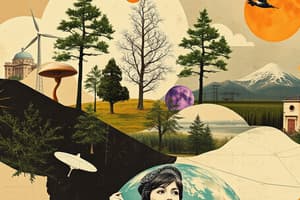Podcast
Questions and Answers
Match the following types of ecosystems with their characteristics:
Match the following types of ecosystems with their characteristics:
Terrestrial = Includes forests, grasslands, and deserts Aquatic = Includes freshwater and marine environments Freshwater = Includes lakes and rivers Marine = Includes oceans and coral reefs
Match the following components of ecosystems with their definitions:
Match the following components of ecosystems with their definitions:
Biotic Factors = Living organisms within an ecosystem Abiotic Factors = Non-living elements in the environment Producers = Organisms that create energy through photosynthesis Decomposers = Organisms that break down dead matter
Match the following cycles with their key processes:
Match the following cycles with their key processes:
Water Cycle = Evaporation, condensation, precipitation Carbon Cycle = Carbon fixation and respiration Nitrogen Cycle = Nitrogen fixation and nitrification Oxygen Cycle = Photosynthesis and respiration
Match the following types of succession with their descriptions:
Match the following types of succession with their descriptions:
Match the following mechanisms of evolution with their descriptions:
Match the following mechanisms of evolution with their descriptions:
Match the following types of speciation with their definitions:
Match the following types of speciation with their definitions:
Match the following evidence of evolution with their examples:
Match the following evidence of evolution with their examples:
Match the following evolutionary theorists with their contributions:
Match the following evolutionary theorists with their contributions:
Flashcards are hidden until you start studying
Study Notes
Ecosystems
-
Definition: A biological community of interacting organisms and their physical environment.
-
Components:
- Biotic Factors: Living organisms (plants, animals, microorganisms).
- Abiotic Factors: Non-living elements (water, air, soil, sunlight).
-
Types of Ecosystems:
- Terrestrial: Forests, grasslands, deserts, tundras.
- Aquatic: Freshwater (lakes, rivers) and marine (oceans, coral reefs) ecosystems.
-
Energy Flow:
- Producers: Organisms that create energy (plants via photosynthesis).
- Consumers: Organisms that consume energy (herbivores, carnivores, omnivores).
- Decomposers: Organisms that break down dead matter (fungi, bacteria).
-
Nutrient Cycling:
- Water Cycle: Evaporation, condensation, precipitation.
- Carbon Cycle: Carbon fixation, respiration, decomposition.
- Nitrogen Cycle: Nitrogen fixation, nitrification, denitrification.
-
Ecological Succession:
- Primary Succession: Development of an ecosystem in lifeless areas (e.g., after a volcanic eruption).
- Secondary Succession: Recovery of an ecosystem after disturbances (e.g., forest fire).
Evolution
-
Definition: The change in the heritable characteristics of biological populations over successive generations.
-
Mechanisms of Evolution:
- Natural Selection: Process where organisms better adapted to their environment tend to survive and reproduce.
- Genetic Drift: Random changes in allele frequencies in a population.
- Gene Flow: Transfer of genetic material between populations.
- Mutation: Changes in DNA that can create new traits.
-
Evidence of Evolution:
- Fossil Record: Shows gradual changes in species over time.
- Comparative Anatomy: Homologous structures (similar structures, different functions) suggest common ancestry.
- Molecular Biology: Similar DNA sequences indicate relatedness among species.
-
Speciation:
- Allopatric Speciation: New species arise due to geographic separation.
- Sympatric Speciation: New species evolve from a single ancestral species while inhabiting the same region.
-
Evolutionary Theory:
- Charles Darwin: Proposed the theory of evolution by natural selection in the 19th century.
- Modern Synthesis: Integrates Darwin’s theory with Mendelian genetics, explaining how evolutionary processes operate on genetic variations.
Ecosystems
- A biological community composed of interacting organisms and their physical environment.
- Biotic Factors: Includes all living organisms like plants, animals, and microorganisms.
- Abiotic Factors: Encompasses non-living elements such as water, air, soil, and sunlight.
- Types of Ecosystems:
- Terrestrial Ecosystems: Includes forests, grasslands, deserts, and tundras.
- Aquatic Ecosystems: Divided into freshwater (lakes, rivers) and marine (oceans, coral reefs).
- Energy Flow:
- Producers: Organisms like plants that generate energy through photosynthesis.
- Consumers: Organisms that obtain energy by consuming others, including herbivores, carnivores, and omnivores.
- Decomposers: Organisms such as fungi and bacteria that break down dead matter, recycling nutrients.
- Nutrient Cycling:
- Water Cycle: Involves processes like evaporation, condensation, and precipitation.
- Carbon Cycle: Includes carbon fixation, respiration, and decomposition.
- Nitrogen Cycle: Comprises nitrogen fixation, nitrification, and denitrification processes.
- Ecological Succession:
- Primary Succession: Occurs in lifeless areas, initiating ecosystem development (e.g., post-volcanic eruption).
- Secondary Succession: Recovery process of an ecosystem following disturbances like forest fires.
Evolution
- A change in heritable characteristics of biological populations across successive generations.
- Mechanisms of Evolution:
- Natural Selection: Organisms best adapted to their environment are more likely to survive and reproduce.
- Genetic Drift: Random fluctuations in allele frequencies can lead to changes in a population.
- Gene Flow: The process of genetic material moving between populations, increasing genetic diversity.
- Mutation: Alterations in DNA that can produce new traits and contribute to evolution.
- Evidence of Evolution:
- Fossil Record: Provides evidence of gradual species changes over geological time.
- Comparative Anatomy: Study of homologous structures (similar anatomy, different functions) suggests common ancestry.
- Molecular Biology: Similarities in DNA sequences among different species indicate evolutionary relationships.
- Speciation:
- Allopatric Speciation: New species arise when populations become geographically isolated.
- Sympatric Speciation: New species evolve from a single ancestral species occurring in the same region.
- Evolutionary Theory:
- Charles Darwin: Introduced the theory of evolution by natural selection in the 19th century, emphasizing adaptation.
- Modern Synthesis: Combines Darwinian evolution with Mendelian genetics to explain how evolutionary processes act on genetic variation.
Studying That Suits You
Use AI to generate personalized quizzes and flashcards to suit your learning preferences.




